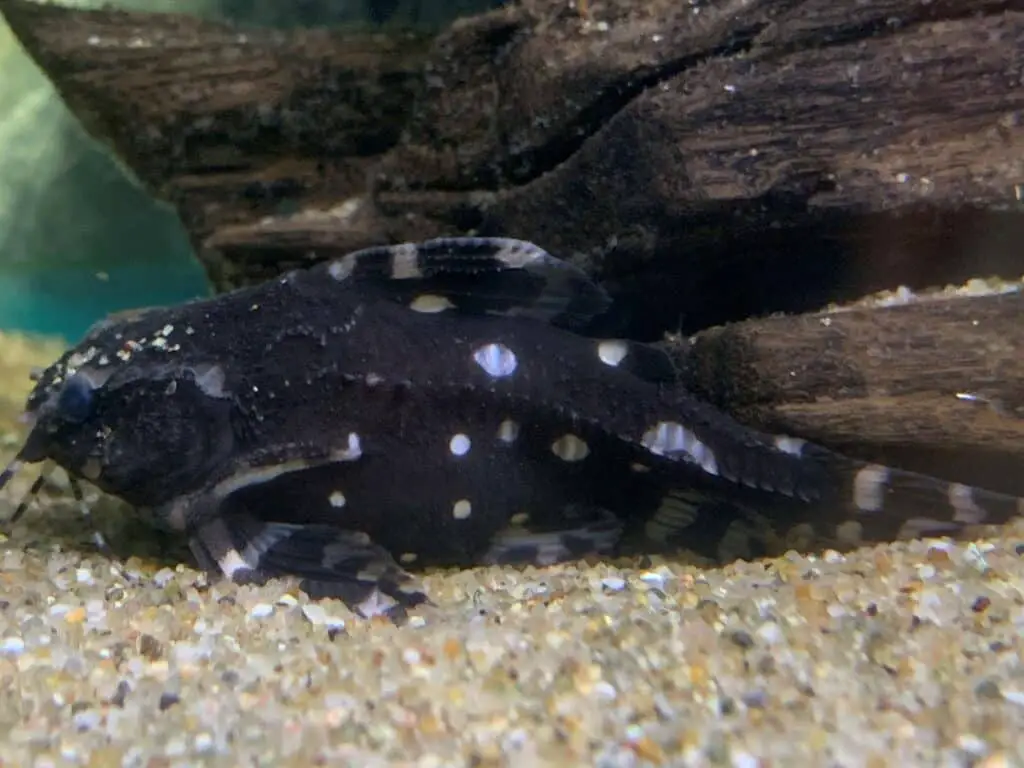If you’re a fan of keeping freshwater fish as pets, then you’re probably familiar with the popular Spotted Raphael Catfish. While they’re a popular choice for many aquariums, they’re also pretty different from other fish in both appearance and temperament.
For one, Raphael Catfish have a very unique appearance. They are named for their spots, which are a type of camouflage that they use to blend in with their surroundings.
Raphael Catfish are also unique in their temperament. They are generally very peaceful fish but can also be quite shy. That’s why it’s important to familiarize yourself with their specific needs if you want to keep one in your home aquarium.

Species Summary
The Spotted Raphael Catfish (Agamyxis pectinifrons) is a tropical freshwater catfish belonging to the Doradidae family and native to South America. It is mainly found in Northern Peru, but its natural range extends to Bolivia, Brazil, Colombia, and Peru. This talking catfish is found in slow-flowing habitats, such as streams and flooded forest areas. It is often found among dry leaves, roots, and driftwood in dark waters that are rich in tannins and white water.
This fish is not-so-common in home aquariums, but that doesn’t mean they’re not a great option for your tank. In fact, they make an excellent choice for aquarists who want to start keeping this type of fish. They can be sensitive to some changes in water parameters, but overall they’re a hardy fish that can adapt to a variety of environments.
Spotted Raphael Catfish Care Guide
This not-so-common species can be a great addition to your tank, and they’re relatively easy to care for. Here’s everything you need to know about the Spotted Raphael Catfish.
Tank Size
As you may know, catfish are known for spending a lot of time still lurking in their caves. Because of this, they don’t require a very spacious tank. In fact, for a Spotted Raphael Catfish, you’ll only need an aquarium that is over 21 gallons, with dimensions starting at 31″ x 11″ x 15″.
Tank Mates
These fish are non-territorial and get along well with other fish, making them ideal tankmates for a variety of different species.
The Spotted Raphael Catfish is a tolerant fish that can be kept in a group, although it can also do well on its own. These fish are known for their playful nature and can often be seen vigorously vying for space with other fish in the tank. However, these competitions are usually harmless, and the fish generally get along well together.
Some great tankmates for the Spotted Raphael Catfish include the Platydoras, Acanthodoras, Amblydoras, Tiger Barb, Zebra Pleco, Rainbowfish, Tetras and Danio species, Carnegiella strigata, Bunocephalus sp., and Otocinclus sp.
Same Species Tanks
Spotted Raphael Catfish is rarely used as a single species in any assembly.
In any case, it is a suitable species to be kept alone in a well-decorated aquarium in a themed or biotope style.
Water Parameters
They are able to support a wide range of water parameters, making them perfect for beginner aquarists. The ideal temperature for Spotted Raphael Catfish is 68 to 79 degrees Fahrenheit. The pH range should be between 6.0 to 7.5, and hardness should be 18 – 357 ppm.
What to Put in Their Tank
Your Spotted Raphael Catfish will need an aquarium heater to maintain a comfortable water temperature and a filtering system to keep the water clean. The filtration system should be sized appropriately for your tank and create a low flow of water. Plus, these fish don’t like bright lights, so keep the lighting low or use floating plants as cover.
The aquarium’s decoration is critical to guaranteeing success in maintaining the species. It is essential to have a tank that mimics their natural habitat conditions, with fine sand as a substrate, plenty of driftwood, and a bed of dry leaves. Make sure the tank is well decorated and has plenty of hiding places and territories for the fish.
Your Spotted Raphael Catfish will spend most of their time on the bottom of the tank, so make sure to use a soft substrate with no edges or angles that could hurt the fish. You can even add some plants to the tank.
Common Diseases
Although they are typically very hardy fish, a few common diseases can affect them. One of the most common diseases affecting Spotted Raphael Catfish is acidosis. Acidosis is often the result of poor water quality or a lack of oxygen in the water.
The best way to prevent acidosis is to maintain a consistent pH level in the tank and to do regular water changes.
Food and Diet
The Spotted Raphael Catfish is an omnivorous fish that will eat most anything. In the wild, they feed on small invertebrates, algae, biofilm, fruits, small fish, and more. In captivity, they will readily accept most commercial foods and live, frozen, or fresh foods such as bloodworms, brine shrimp, and daphnia.
When it comes to feeding your Spotted Raphael Catfish, it is best to offer them small meals several times per day. This will ensure that they are getting the nutrition they need without overfeeding them. Removing any uneaten food from the tank is also important to prevent water quality issues.
Lifespan
As long as the aquarium has stable water parameters and the fish is fed a nutritious diet, it will thrive. The average lifespan of the Spotted Raphael Catfish is 5-8 years in captivity.
Spotted Raphael Catfish are not as long-lived in the wild as their aquarium-dwelling counterparts. These fish are susceptible to diseases, attacks from other animals, and environmental conditions that can shorten their lifespan.
Appearance
Their bodies have the classic shape of a catfish, with a slightly flattened outline. They have large flat bellies and rounded backs and are flanked by a pair of spike lines. Their eyes are positioned on top of their heads, giving them a frightening and primitive appearance.
Despite their scary look, Spotted Raphael Catfish are actually quite peaceful fish.
Size
This unique fish can quickly grow to 5.9 inches in length when well cared for and fed, but the everyday sight is around 5 inches.
Behavior and Temperament
They’re very sedentary, staying hidden in areas with some light present and only becoming more active at night when they’ll swim and explore near the bottom of the aquarium.
These fish don’t school together, but they are gregarious by nature, so they’ll exhibit more natural behavior when kept in a group of at least four individuals. When kept alone, they may group with other fish that look similar to them, such as Platydoras and Acanthodoras.
Breeding
One of the most difficult fish to successfully breed in an aquarium is the Spotted Raphael Catfish.
These beautiful fish are oviparous, meaning they lay eggs, and are bubble-nest builders. The female fish will lay her eggs on a mop or piece of surface vegetation, and the parents do not display any parental care.
Gender Differences: Male vs Female
There don’t seem to be any clear gender differences. However, some experienced hobbyists say that adult females are generally wider and more robust when viewed from above – especially in the ventral region. So, if you’re trying to sex your Raphael Catfish, it’s worth taking a close look at these physical traits.
Spotted Raphael Catfish Fun Facts
● The nickname “talking fish” is derived from the fish’s ability to produce sounds when communicating with conspecifics or when threatened. It can make these sounds in two ways. The first involves partially blocking the pectoral fins at their bases, where the fish can then scrape the pectoral spines.
The second is contracting and relaxing a muscle wedged between the back of the skull and the front of the swim bladder. This causes the bladder to resonate and produce a slightly deeper sound. Noises are audible.
● This species can be very common in the aquarium hobby and is a highly recommended species for beginners; although it is not seen very regularly, it is very resistant, attractive, and relatively long-lived.
References
Cope, E. D. 1870 – Proceedings of the American Philosophical Society 11: 559-570
Contribution to the ichthyology of the Marañon.
Correa, S. B., W. G. R. Crampton, L. J. Chapman and J. S. Albert. 2008 – Journal of Fish Biology 72: 629–644. A comparison of flooded forest and floatingmeadow fish assemblages in an upper Amazon floodplain.
Ferraris, C. J., Jr. 2007 – Zootaxa 1418: 1-628. Checklist of catfishes, recent and fossil (Osteichthyes: Siluriformes), and catalogue of siluriform primary types.
Ortega, H. and R. P. Vari. 1986- Smithsonian Contributions to Zoology 437. Annotated checklist of the freshwater fishes of Peru.
Reis, R. E., S. O. Kullander and C. J. Ferraris, Jr. 2003 – In: Checklist of the Freshwater Fishes of South and Central America Doradidae (Thorny catfishes).
Sabaj, M.H. and C.J. Ferraris Jr., 2003. Doradidae (Thorny catfishes). p. 456-469. In R.E. Reis, S.O. Kullander and C.J. Ferraris, Jr. (eds.) Checklist of the Freshwater Fishes of South and Central America. Porto Alegre: EDIPUCRS, Brasil.
Sousa, L. M. D. (2010). Revisão taxonômica e filogenia de Astrodoradinae (Siluriformes, Doradidae). (Doctoral dissertation, Universidade de São Paulo).
Swedish Museum of Natural History. 1999 – Ichthyology Section, Department of Vertebrate Zoology, Swedish Museum of Natural History, Stockholm, Sweden. NRM Ichthyology collection database.








